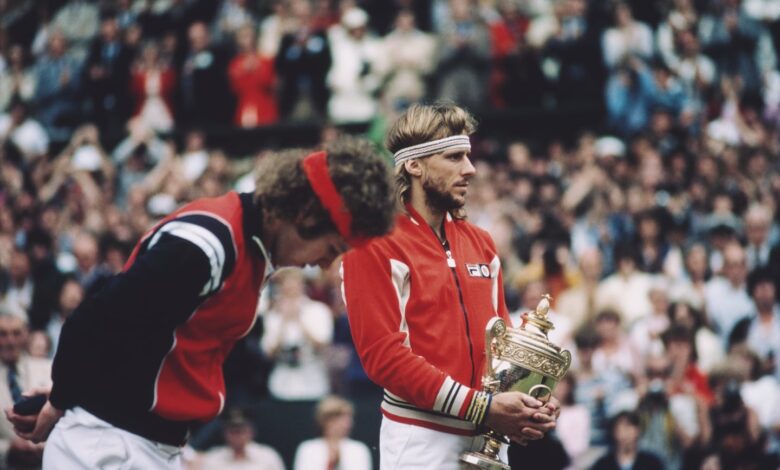Wimbledon 2024 can’t compare with the drama that Borg vs. McEnroe served in 1980

Like everyone else with an interest in tennis, I’m watching Wimbledon. But for years, I didn’t. Seeing the world’s best players serve and volley on the grass courts of the All England Lawn Tennis and Croquet Club was too emotional. If that seems weird, it is, especially because I was a tennis fanatic as a teenager.
I was a glutton for the game. I’d spend hours at the Smith College courts, hitting with friends or people I didn’t know or, if no one was around, against the backboard. And when I wasn’t sharpening my groundstrokes, I’d be watching whatever tennis I could find on television. There wasn’t much in those days, just the four Grand Slam tournaments — the Australian Open, French Open, Wimbledon, and the US Open. I watched them all, but Wimbledon was appointment TV.
That changed in July 1980, a few weeks before my 15th birthday, when Bjorn Borg and John McEnroe met in the men’s final at Wimbledon. I watched the match in a bed & breakfast in Weston, Vt., where I was spending the July 4th weekend with my folks. They were on their own, though. As long as Borg and McEnroe were hitting winners on Centre Court, I wouldn’t be touring any 18th-century sawmills.
I was obsessed with Borg, a stoic, good-looking Swede with shaggy hair and headband who wore a stylish FILA pinstripe shirt and weirdly tight short shorts. He was austere on the court, always under control — the opposite of his opponent, my other favorite player, McEnroe, an Eraserhead lookalike who, at 20, had established himself as the enfant terrible of American tennis for his habit of yelling insults at umpires and line judges. (That summer, he was appropriately nicknamed “Superbrat” by the British tabloids.)
“You’re the pits of the world!” McEnroe famously screamed at one poor Wimbledon ump.
I don’t need to tell you how amazing that 1980 final was, or at least I shouldn’t have to. Several books and a documentary are devoted to the Borg-McEnroe rivalry and there’s a pretty decent movie, “Borg vs. McEnroe,” focused on the legendary duel, which Borg eventually won in five thrilling sets. (McEnroe beat him the next year, blocking Borg from a sixth consecutive Wimbledon crown.)
Lasting nearly four hours, the 1980 final was incredible television; NBC commentators Dick Enberg and Bud Collins, the grandiloquent Globe columnist, marveled at the exquisite shotmaking but also had the good sense to keep quiet for long stretches, letting the drama do the talking. When it was over, Borg dropped to his knees in celebration and, alone in the living room of the quaint B&B, I collapsed into an old wingback chair, unsure if I was happy or sad.
It took me years to recover. Why? Wimbledon is the oldest, most prestigious tournament in tennis. For fans of the game, Centre Court might as well be the Colosseum (though Romans didn’t enjoy chilled champagne, and strawberries and cream, while watching gladiators do hand-to-hand combat). The end of the 1980 Wimbledon final felt like the end of the summer, and that feeling persisted for decades.
In fact, throughout my 20s, 30s, and 40s, I resisted watching Wimbledon because I knew it was all downhill once it was over; the descent into fall began as soon as the new men’s and women’s champions hoisted their trophies. Ridiculous, I know, but I’d been traumatized by the intensity and excellence of that Borg-McEnroe match, and if I didn’t want that summer feeling to end every year in July, I had to stop watching Wimbledon.
Turns out it wasn’t that difficult. Because, with the exception of Serena Williams, who won seven Wimbledon titles, most of the men’s and women’s champs in the ‘90s, ‘00s, and 2010s lacked the charm or charisma of Borg and McEnroe. Pete Sampras was a terrific player — like Williams, he won seven times at Wimbledon — but he had zero personality; Sampras was an automaton. Likewise, Novak Djokovic, the Serb assassin who’s chasing his eighth Wimbledon title, is hard to get excited about. If Borg made tennis cool — he was photographed at Studio 54 with Bianca Jagger back in the day — Djokovic did the opposite, adopting an almost ascetic approach to the game that can feel joyless.
(I did like Roger Federer, and apparently his match against Andy Roddick in the 2009 Wimbledon final had some emotion; Federer won the fifth set 16-14.)
I’m back to watching now. I’ve grown up, I guess. When Wimbledon got underway last week, I was in front of my TV, safe in the knowledge that regardless of what happens at the All England Club, summer won’t officially be over until Sept. 22. I’m excited to be watching again, to see the game’s new stars — Carlos Alcaraz and Jannik Sinner and Emma Navarro and Jasmine Paolini — hammering topspin forehands and slice backhands on those fast grass courts.
But there is one thing that bothers me about Wimbledon in 2024. It seems the tournament’s all-white dress code, which has been in place since the 1800s, is being enforced more emphatically than ever. Today, it’s doubtful that McEnroe would be allowed to wear his funky red headband or Sergio Tacchini shirt with red-white-and-blue sleeves, and the blue collar and dark lines of Borg’s FILA shirt would also be a no-no.
That’s a problem. When everyone wears white, it becomes a uniform. Players are indistinguishable; there’s no room for individuals, eccentricities, or fashion statements. The thing about the 1980 Wimbledon final is that Borg and McEnroe were unique, and what they did on Centre Court that afternoon was unforgettable.



